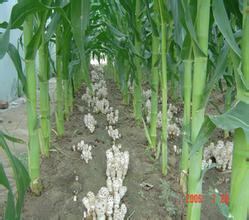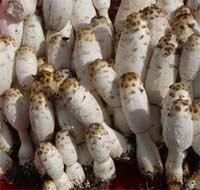How to interplant Coprinus comatus in chili field

Interplanting Coprinus comatus in pepper field is a good method to imitate wild cultivation of Coprinus comatus, which can save the cost of building mushroom house, does not occupy space, and can greatly improve the economic benefit per unit land area. Generally, after the pepper is planted, trenches are opened, materials are laid and bacteria are spread in the middle of the pepper row. For the convenience of managing and harvesting mushrooms and peppers, three pepper stalls can be planted in succession, and another chili stall can be left as a walkway. The trench was opened in the middle of the chili row where the chicken leg mushroom was planted, the ditch was 17 cm wide and 25 cm deep, and the length was equal to the length of the chili row. The length × width of the trench × the number of ditches opened in the area is the total area of interplanting Coprinus comatus in the land, with 20 kg of feed per square meter and 3 kg of sowing (that is, 15% of the raw material). In the interplanting of Coprinus comatus in hot pepper field, the culture material should be treated first, then ditched, disinfected, spread and planted. The technical requirements are as follows: in order to save cost and have sufficient raw materials, Coprinus comatus can be cultivated directly with whole straw (rice straw, wheat straw). The treatment method is as follows: the dry and mildew-free whole grass is tied into small bundles of about 5 kilograms, soaked in 3% lime water in batches for 15 minutes for 20 minutes, picked up, leached to no droplets, and then fermented. Spread the bottom film on the cement floor or cultivation ground, cover the bottom with a 10-15 cm thick stick, lay the Bale on the stick and put it in piles. The whole stack membrane was wrapped together with the bottom film to ferment, and the pile was turned over after one day when the heap temperature rose above 60 ℃. Another bottom film will transfer the Bale directly to the bottom film to form a new pile, remove the sticks from the original bottom film, and the new pile will be covered with film together with the bottom film to continue fermentation. Keep it for another day when the heap temperature rises above 60 ℃, then loosen the binding rope and loose the film, and cultivate it when the temperature drops to about 30 ℃. Before interplanting, trench the ground of pepper stalls and sprinkle 3% of lime water for disinfection. Before laying the grass, sprinkle a layer of sifted dry animal dung at the bottom of the ditch, then spread the bales, and spread the whole grass evenly along the ditch. The bottom layer is about 5 cm thick, the seed is 3%, sprinkle a layer of dry animal dung moistened by 3% lime water, the middle layer is about 10 cm thick, the sowing rate is 5%, and sprinkle a layer of dry animal dung. The upper layer of grass is about 10 cm thick and the sowing rate is 7%. Sprinkle a layer of dry animal dung, flatten the bed with spades and planks, take wet vegetable garden soil to cover 3 cm to 4 cm thick, spray moist cover soil with 0.5% lime water, and sprinkle it with a layer of plant ash. It is managed according to the growth of hot pepper, but can not be irrigated until the hyphae of Coprinus comatus penetrates the forage and breaks through the soil. Pay attention to the problem ① chili pepper seedlings should be filled in time, so that Coprinus comatus can get good sunshade. When using medicine to treat diseases, ② chili should first cover the cultivation or growth of Coprinus comatus with film, and then take it off after the liquid is dry, so as to avoid drug damage.
- Prev

Storage and preservation techniques of lily
Lily originated in East Asia, in Europe and the United States as a flower cultivation, China is harvested bulbs as food crops cultivation. There are not many species of lily pests, but the damage is serious, and the loss rate in serious disease years reaches 30%~60%. In order to control lily diseases and insect pests, we conducted a survey of lily diseases and insect pests in Shaodong area from 1993 to 1998.
- Next

The benefit of making good use of space is doubled to grow Coprinus comatus under black fungus.
Distiller's grains is a good raw material for edible mushroom cultivation, and its nutrients are suitable for the growth of Coprinus comatus hyphae, which can not only reduce the production cost of Coprinus comatus, but also prevent environmental pollution. Distiller's grains contains a small amount of ethanol and active yeast which are harmful to mycelium growth, the acidity is high, and the pH value is 3-5. So choose fresh distiller's grains.
Related
- Fuxing push coffee new agricultural production and marketing class: lack of small-scale processing plants
- Jujube rice field leisure farm deep ploughing Yilan for five years to create a space for organic food and play
- Nongyu Farm-A trial of organic papaya for brave women with advanced technology
- Four points for attention in the prevention and control of diseases and insect pests of edible fungi
- How to add nutrient solution to Edible Fungi
- Is there any good way to control edible fungus mites?
- Open Inoculation Technology of Edible Fungi
- Is there any clever way to use fertilizer for edible fungus in winter?
- What agents are used to kill the pathogens of edible fungi in the mushroom shed?
- Rapid drying of Edible Fungi

